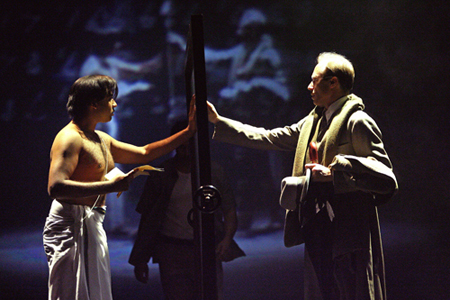"A mathematician, like a painter or poet, is a maker of patterns. If his patterns are more permanent than theirs, it is because they are made with ideas."

Shane Shambhu as Ramanujan and David Annan as Hardy in the play A disappearing number. Photo: Tristram Kenton.
This beautiful sentence is from G.H. Hardy's 1940 essay A mathematician's apology. The work was Hardy's attempt to justify the pursuit of pure maths to non-mathematicians and to explain its motivation. It focuses on the beauty of maths and, unlike many other attempts to make maths appear attractive, takes pride in the un-applicability of pure maths — partly because something that has no applications can't do any harm. It's an understandable sentiment for a pacifist like Hardy at the time of WWII. And although Hardy was proved very wrong about the "purity" of his own field, number theory, which is today used in cryptography, it's still a fascinating and thought-provoking read.
In the Apology Hardy also mentions the mathematician Srinivasa Ramanujan, who played a defining part in Hardy's mathematical life:
"I still say to myself when I am depressed, and find myself forced to listen to pompous and tiresome people, 'Well, I have done one the thing you could never have done, and that is to have collaborated with both Littlewood and Ramanujan on something like equal terms.'"
Hardy's collaboration with the self-taught Indian genius was remarkable. It inspired the 2008 play, A disappearing number, which we explored in this Plus article. You can also listen to our podcast with actor and mathematician Victoria Gould reading a section from the foreword to Hardy's Apology.
Return to the Plus Advent Calendar